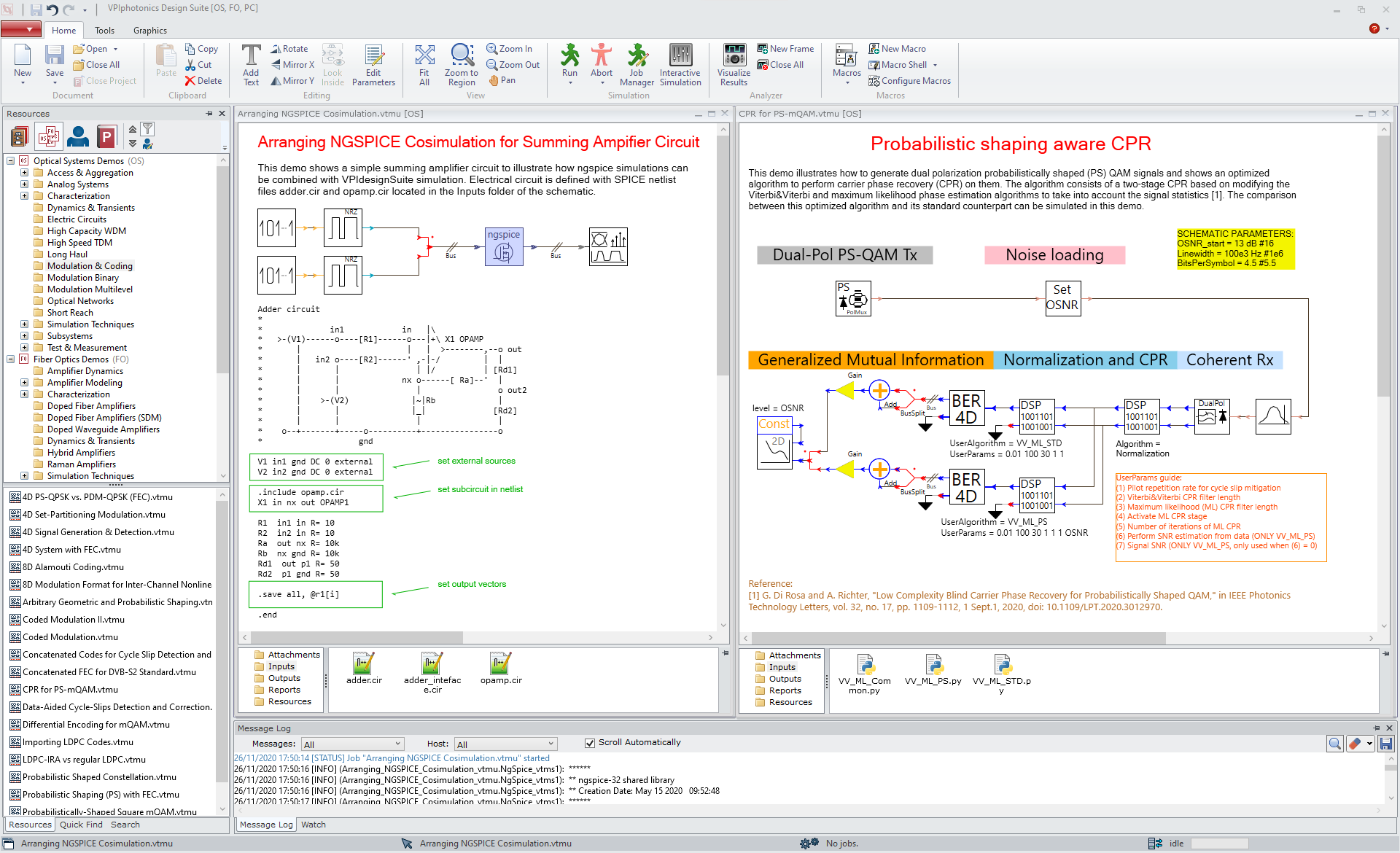VPIphotonics Design Suite Version 11.1 provides access to professional application-specific simulation tools and several pluggable toolkit extensions with common usability, design process and data analysis capabilities.
Version 11.1 offers advances in simulation and design flow for applications using
Probabilistically Shaped QAM with polarization multiplexing, Digital Signal Processing, PAM4 signaling,
transient SPICE simulations, integrated optical modulators, multimode fibers and couplers, and more.
VPIphotonics' software solutions have proven to be beneficial in winning and successfully
performing many research and design projects – for commercial companies as well as for
educational institutions. With the improved capabilities provided in Version 11.1, our
modeling suite is set to deliver the same outstanding results in the future.

Photonic Design Environment (PDE) of Version 11.1
High-Order Modulation – New standard global parameters that specify symbol rate, number of simulated symbols and bits per symbol.
Dual-Pol PS-mQAM – New Dual-Polarization (DP) transmitter module for Probabilistically Shaped m-ary Quadrature Amplitude Modulation (PS-mQAM) signals
CPR for PS-mQAM – New demonstration illustrating the application of an optimized Digital Signal Processing (DSP) algorithm for the Carrier Phase Recovery (CPR) for DP (PS-) mQAM signals
TDE-MIMO – Enhanced DSP algorithm for the Time Domain Equalizer with Multiple Inputs Multiple Outputs (TDE-MIMO) to ensure compatibility with the external power normalization and to support Binary Phase Shift Keying (BPSK) modulation format.
Bit-2-Symbol Mapping – New demonstration showing how to display and store (image and code file) the bit-to-symbol mapping of complex modulated optical channels
PAM4 Metrics – New instrumentation module for calculating important 4ary Pulse Amplitude Modulation (PAM4) signal metrics.
Microring Modulator – New system-level model for microring modulator (MRM) that accounts for both, electrical and optical characteristics. The physical and behavioral junction models simulate silicon-based MRMs with a depletion-type phase shifter, or arbitrary user-defined MRMs. The model features are illustrated in several application examples.
SPICE simulations – Support of transient SPICE simulations for detailed modeling of electronic devices (e.g., laser drivers and transimpedance amplifiers) and equivalent circuits of optoelectronic components (e.g., parasitic circuits and junction models).
Device Characterization – Updated instrumentation modules for automated characterization of semiconductor lasers, optical modulators, optical amplifiers, and multimode VCSELs.
PhotonicsTLM Control – New macro that greatly simplifies the simulation settings when using multiple PhotonicsTLM modules and/or TLM-based galaxies in one schematic.
Block-2-Samples Conversion – Easy creation of schematics that can switch between Block Mode and Sample Mode by changing a single control parameter of the BlockToSample and SampleToBlock modules.
Multimode Coupling – Enhanced multimode coupler models that support advanced imaging systems with multiple optical elements (such as lenses, apertures, spatial light modulators) separated by free-space propagation. New demonstration shows how to couple a Gaussian beam into specific modes of a few-mode fiber using a spatial light modulator and a lens. A basic black-box imaging system model described by just the magnification value is also available.
MMF Characterization – New test bench for measuring chromatic dispersion and dispersion slope of multimode fibers in accordance with the IEC 60793-1-42 standard.
Simplified Design Flow – New macro for adding null sources and ground terminations to open module ports.
Python IDEs – Intelligent code completion and context help is now available in Integrated Development Environments (such as PyCharm, Visual Studio) when developing source code that uses VPIphotonics Python modules.
Many new demo examples have been added and existing ones modified to illustrate the functionality and applications of the new features and modules. Version 11.1 provides access to over 880 ready-to-run demo setups now.
This example illustrates how to simulate selective mode excitation using a multimode beam-to-fiber coupler
module. An input Gaussian beam is transmitted through a free-space channel containing a phase spatial light
modulator (SLM) and a lens.
The SLM phase mask represents the phase pattern of the LP mode, which should be excited in the fiber. The
multimode coupler module calculates coupling coefficients to the fiber modes, as well as the input and transmitted
beam intensity profiles and the intensity profile at the fiber facet observed after coupling. The step-index fiber has a
core diameter of 15 um and supports 10 modes.
On the bottom we see how the input Gaussian beam is converted to an LP31-like field pattern using the phase-
SLM followed by a lens and then coupled into the LP31 mode of a few-mode fiber.